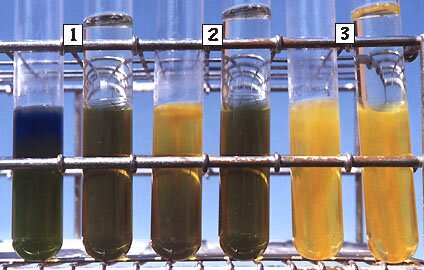|
Glucose O/F Medium (like Glucose Fermentation Broth) includes three key ingredients:
- Glucose is a sugar from which most common chemoheterotrophic bacteria can obtain energy by fermentation and/or respiration. Glucose can also be utilized as a source of carbon, but these media include a large number of potential carbon sources (amino acids as well as glucose), and whether or not glucose is used as a carbon source cannot be directly determined from the reactions seen in these media.
- Peptone is a commonly-used medium ingredient which mainly supplies amino acids (sources of nitrogen, carbon, sulfur and energy for many bacteria). A minimum amount of peptone should be incorporated in the medium, as overabundance of ammonium (alkaline) released from deamination of amino acids can neutralize the acids.
- pH indicator: Brom-thymol blue turns yellow with a net acidic pH and blue with a net alkaline pH.
Whether an organism can respire or ferment glucose can be tested with Glucose O/F Medium. A small amount of acid production can be associated with glucose respiration and can be distinguished where a strict aerobe is growing – i.e., at the top of the medium. If the organism were a facultative anaerobe, this acid formation would not be distinguishable due to the large amount of acid associated with fermentation which would be diffusing throughout the medium.
Duplicate tubes are inoculated for each organism, and the medium in one of the tubes is overlayed with mineral oil. Mineral oil does not in itself cause anaerobic conditions but rather prevents oxygen from continuing to diffuse into the medium. After incubation, one looks for the presence and location of growth and acid.
It is important to emphasize that this medium contains relatively less peptone and more glucose than Glucose Fermentation Broth, so the acid associated with respiration can be detected in the aerobic part of the non-overlayed tube – if it is not made indistinguishable by acid production from fermentation which turns both tubes yellow throughout.
Note the examples shown below. For each pair of tubes, the tube on the right was overlayed with mineral oil after inoculation.
- First pair of tubes: Tubes were inoculated with a strict aerobe which neither respires nor ferments glucose – therefore no acidic reaction. The blue alkaline reaction shows up where there is growth at the top of the "aerobic" tube. This is the negative reaction.
- Second pair of tubes: Tubes were inoculated with a strict aerobe which respires but does not ferment glucose. The small amount of acid associated with respiration shows up where there is growth at the top of the "aerobic" tube. This is the "O" reaction, typical for most species of Pseudomonas. (The alkaline reaction from amino acid deamination is overneutralized.)
- Third pair of tubes: Tubes were inoculated with a facultative anaerobe – i.e., one which can respire (with O2) and ferment. Acid from the fermentation of glucose diffuses throughout both the "aerobic" and "anaerobic" tubes. This is the "F" reaction, typical of the enterics. (The alkaline reaction from amino acid deamination is overneutralized. Also, one cannot discern any acid production that might be associated with respiration.)
|

|
| Pair of Tubes: |
1st |
2nd |
3rd |
Aerobic deamination of amino acids – not relevant to glucose catabolism.
(This occurs in upper part of open tube.) |
+
(Alkaline rxn. not over-neutralized by any acid production.) |
+
(Alkaline rxn. over-neutralized by acid.) |
+
(Alkaline rxn. over-neutralized by acid.) |
Respiration of glucose.
(Acid formed in upper part of open tube; would be impossible to discern if acid from fermentation is present.) |
– |
+! |
(probably positive) |
Fermentation of glucose.
(Acid diffuses throughout both tubes.) |
– |
– |
+!! |
| Reaction recorded: |
Negative |
O |
F |
|
